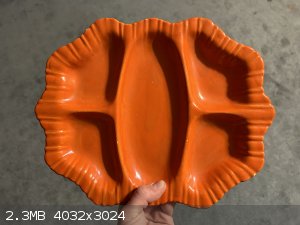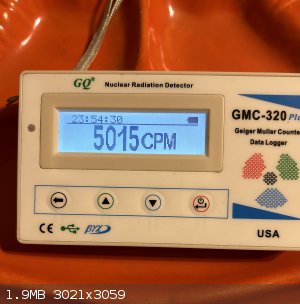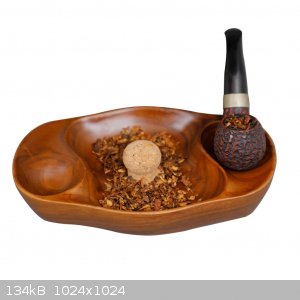Sir_Gawain
Hazard to Others
  
Posts: 490
Registered: 12-10-2022
Location: [REDACTED]
Member Is Offline
Mood: Still in 2022
|
|
Extracting uranium from fiestaware
So I recently found this plate at the thrift store.

It isn’t Fiestaware brand, but it’s certainly the uranium glazed kind. It’s slightly hotter than my pair of radium watch hands. (My Geiger
counter can only detect beta and gamma)

I’m thinking of trying to extract the uranium from it. To do this, I’m gonna have to grind it up which I don’t like.
Is this even a good idea?
“Alchemy is trying to turn things yellow; chemistry is trying to avoid things turning yellow.” -Tom deP.
|
|
|
Trashcanman
Harmless

Posts: 25
Registered: 23-1-2024
Member Is Offline
|
|
Quote: Originally posted by Sir_Gawain  | So I recently found this plate at the thrift store.
It isn’t Fiestaware brand, but it’s certainly the uranium glazed kind. It’s slightly hotter than my pair of radium watch hands. (My Geiger
counter can only detect beta and gamma)
I’m thinking of trying to extract the uranium from it. To do this, I’m gonna have to grind it up which I don’t like.
Is this even a good idea? |
I don't think that this a good idea. Just buy some uranium ore and start from there.
Uranium Refinement
BTW: That "plate" looks to me like it was made for people to put down their pipes.
A pipe per corner of the plate. I am probably wrong but that was my first thought.

[Edited on 5-4-2024 by Trashcanman]
|
|
|
Sir_Gawain
Hazard to Others
  
Posts: 490
Registered: 12-10-2022
Location: [REDACTED]
Member Is Offline
Mood: Still in 2022
|
|
Yeah, I just did the math and the plate likely has an even lower uranium content than some low-grade ore I have. I estimate the ore to contain about
1-5% uranium; and while the glaze on the plate is about 15% uranium, the whole thing only has a thin layer of glaze. The biggest problem with
extraction from the plate is that the glaze is vitrified and the acid is going to have a hard time dissolving it.
“Alchemy is trying to turn things yellow; chemistry is trying to avoid things turning yellow.” -Tom deP.
|
|
|
j_sum1
Administrator
       
Posts: 6372
Registered: 4-10-2014
Location: At home
Member Is Offline
Mood: Most of the ducks are in a row
|
|
If you were going to do it, my thoughts are that the simplest approach would be to put on a decent gas mask and grind off the glaze with an angle
grinder. I would work outside and do the grinding inside a cardboard box to catch all the particles.
Edit
It is a butt-ugly piece of pottery so no real loss if it is destroyed
[Edited on 5-4-2024 by j_sum1]
|
|
|
Sulaiman
International Hazard
    
Posts: 3779
Registered: 8-2-2015
Member Is Offline
|
|
Looks like a 60's nut dish, Brazil, Hazel, Wallnuts etc.
With a nut-cracker in the middle.
Even if you wear a mask, dust will linger somewhere,
not worth the risk + effort I suggest.
CAUTION : Hobby Chemist, not Professional or even Amateur
|
|
|
Trashcanman
Harmless

Posts: 25
Registered: 23-1-2024
Member Is Offline
|
|
Quote: Originally posted by Sulaiman  | Looks like a 60's nut dish, Brazil, Hazel, Wallnuts etc.
With a nut-cracker in the middle.
Even if you wear a mask, dust will linger somewhere,
not worth the risk + effort I suggest. |
It is just uranium.
It is not like he has somehow acquired powdered plutonium.
He will probably unintentionally ingest small amounts of uranium but as long as he properly washes his hands there shouldn't be any problems.
Decontamination of hands
|
|
|
Fulmen
International Hazard
    
Posts: 1748
Registered: 24-9-2005
Member Is Offline
Mood: Bored
|
|
The OP might be in over his head here. While there is no reason for hysteria, uranium is nevertheless a toxic and radioactive heavy metal. This will
demand proper precautions.
Fortunately it's simple to detect using a geiger.
Avoiding the dust phase would be preferable, what about digestion in molten sodium hydroxide? That's another high hazard material though...
We're not banging rocks together here. We know how to put a man back together.
|
|
|
Trashcanman
Harmless

Posts: 25
Registered: 23-1-2024
Member Is Offline
|
|
Quote: Originally posted by Fulmen  | The OP might be in over his head here. While there is no reason for hysteria, uranium is nevertheless a toxic and radioactive heavy metal. This will
demand proper precautions.
Fortunately it's simple to detect using a geiger.
Avoiding the dust phase would be preferable, what about digestion in molten sodium hydroxide? That's another high hazard material though...
|
Agreed but he has already dealt with radium and thereby I am certain that he will have no trouble with uranium xD
[Edited on 6-4-2024 by Trashcanman]
|
|
|
Sir_Gawain
Hazard to Others
  
Posts: 490
Registered: 12-10-2022
Location: [REDACTED]
Member Is Offline
Mood: Still in 2022
|
|
Simply owning radium isn’t the same as grinding up uranium ore into fine dust and dissolving into solution. I think I’ll let
the plate live, and try a carbonate leach on the ore I have.
“Alchemy is trying to turn things yellow; chemistry is trying to avoid things turning yellow.” -Tom deP.
|
|
|
Trashcanman
Harmless

Posts: 25
Registered: 23-1-2024
Member Is Offline
|
|
Quote: Originally posted by Sir_Gawain  | | Simply owning radium isn’t the same as grinding up uranium ore into fine dust and dissolving into solution. I think I’ll let
the plate live, and try a carbonate leach on the ore I have. |
I assumed you that you tried to seperate the radium from the paint for use in combination with beryllium as a neutron source.
Do you use the watch hands as a check source or do you simply like to collect radioactive material? 
|
|
|
Sulaiman
International Hazard
    
Posts: 3779
Registered: 8-2-2015
Member Is Offline
|
|
just a bit of trivia
At one place I worked we repaired electronics for nuclear power stations,
one equipment type commonly repaired was radiation alarms,
The alarms should activate when ionising radiation levels are higher than a threshold, obvious,
the alarms should also sound if no ionising radiation is detected
because there is a thorium heating mantle stuffed into the probe.
(No ionisation detected means an instrument fault)
If you make an alarm for your lab,
a chip off the plate could perform a similar function.
PS same reason 20mA instruments don't use 0-20mA but use 4-20mA.
[Edited on 6-4-2024 by Sulaiman]
CAUTION : Hobby Chemist, not Professional or even Amateur
|
|
|
phlogiston
International Hazard
    
Posts: 1381
Registered: 26-4-2008
Location: Neon Thorium Erbium Lanthanum Neodymium Sulphur
Member Is Offline
Mood: pyrophoric
|
|
If you are going to powder this plate (or U ore for that matter), you should really try to be extremely hygienic and take measures to avoid any kind
of contamination of your work place or house with U-containing dust.
Ingesting particles isnt good, but inhaling them is what you really should be careful to avoid. Particles of insoluble alpha-emitters stuck deep in
your lungs is really bad. The alpha irradiation of the local tissue around them, isgnificantly increases the odds for lung cancer.
The angle grinder is going to be really messy and honestly doesn't sounds like a safe idea.
Maybe a ball mill would be better suited, because you can close it hermetically, do the grinding, and then allow the dust to settle down before
opening it (gently). You can also wet the powder to prevent airborn dust down while handling the powder.
-----
"If a rocket goes up, who cares where it comes down, that's not my concern said Wernher von Braun" - Tom Lehrer |
|
|
Rainwater
National Hazard
   
Posts: 987
Registered: 22-12-2021
Member Is Offline
Mood: Break'n glass & kick'n a's
|
|
Given the fact that inhaling non-radioactive ceramic dust can cause incurable health problems, and this is an extraction of a toxic heavy metal
Why not use a hot sodium hydroxide bath?
It has a completely different way to hurt you, but no dust
"You can't do that" - challenge accepted
|
|
|
Sir_Gawain
Hazard to Others
  
Posts: 490
Registered: 12-10-2022
Location: [REDACTED]
Member Is Offline
Mood: Still in 2022
|
|
Do you mean a concentrated solution or molten sodium hydroxide?
“Alchemy is trying to turn things yellow; chemistry is trying to avoid things turning yellow.” -Tom deP.
|
|
|
j_sum1
Administrator
       
Posts: 6372
Registered: 4-10-2014
Location: At home
Member Is Offline
Mood: Most of the ducks are in a row
|
|
I did say gas mask rather than just a dust mask. I assumed that particulates could be managed. If you think that is not possible, then, yeah - dumb
idea.
|
|
|
EF2000
Hazard to Others
  
Posts: 154
Registered: 10-5-2023
Location: The Steppes
Member Is Offline
Mood: Taste testing the Tonka fuel
|
|
What about putting the plate into a sealed plastic bag (even better double plastic bag), breaking it with hammer to small pieces, and dissolving those
pieces one by one in sodium hydroxide? This way avoiding both a cloud of radioactive dust and a need to handle large amounts of molten hydroxide.
Wroom wroom
"The practice of pouring yourself alcohol from a rocket fuel tank is to be strongly condemned encouraged"
-R-1 User's Guide
|
|
|
Rainwater
National Hazard
   
Posts: 987
Registered: 22-12-2021
Member Is Offline
Mood: Break'n glass & kick'n a's
|
|
This really depends on your comfort level. Molten NaOH will eat through the most stubborn rocks I process(FeOx&AlOx rich),
Producing Sodium Silicate and a mixed oxide slurry very quickly. You may be able to use it to remove the glaze, and simplify the extraction. Your
target is in a different group, Not group but, lower down on the ladder, than mine, so I expect the process to be different. For example, when
processing tungsten materials (heating/incandescent wire, drill bits, hole saws etc). the easiest way for me to separate the W from the alloys is
molten NaOH + KNO3 in a graphite cursable, car u s able, black thingy hot dont melt thingy. the cooled solid salts are dissolved in water
and filtered. the W is in the filtrate.
U being in the same group as W, I expect the process to be similar. This is based on absolutely no reading or experience with your target element.
"You can't do that" - challenge accepted
|
|
|
Sir_Gawain
Hazard to Others
  
Posts: 490
Registered: 12-10-2022
Location: [REDACTED]
Member Is Offline
Mood: Still in 2022
|
|
I chipped off a small piece of glaze and added it to nitric acid. After a few days, the glaze was colorless and the acid turned yellow from uranyl
nitrate.
I created a procedure, what do you guys think of:
•Crush plate to fine powder
•Ball mill?
•Leach out uranium and lead with nitric acid
•Precipitate lead with sulfuric acid?
•Precipitate uranium with ammonium or sodium hydroxide
•Redissolve uranium with carbonate leach
•Acidify carbonate solution and precipitate uranium with hydrogen peroxide
Steps with a ? are ones I’m not sure are necessary
Alternatively, I could try a carbonate leach on the crushed plate directly, though I doubt that will dissolve much. Digestion in sodium hydroxide is
also feasible, though I’d rather not deal with that much highly caustic solution.
“Alchemy is trying to turn things yellow; chemistry is trying to avoid things turning yellow.” -Tom deP.
|
|
|
Rainwater
National Hazard
   
Posts: 987
Registered: 22-12-2021
Member Is Offline
Mood: Break'n glass & kick'n a's
|
|
What safety procedures and ppe will be used?
"You can't do that" - challenge accepted
|
|
|
Sir_Gawain
Hazard to Others
  
Posts: 490
Registered: 12-10-2022
Location: [REDACTED]
Member Is Offline
Mood: Still in 2022
|
|
Gloves, gas mask, and a windy day 
“Alchemy is trying to turn things yellow; chemistry is trying to avoid things turning yellow.” -Tom deP.
|
|
|
Rainwater
National Hazard
   
Posts: 987
Registered: 22-12-2021
Member Is Offline
Mood: Break'n glass & kick'n a's
|
|
How about cleanup? That will be the most difficult to do properly
Reguardless of what heavy metal your dealing with.
if your dead set on pulverizing the materal, i would recommend a wet process.
In a metal container, cover the dish with a foot of water and break into pieces
Crush until the consistency of muddy water.
Filter the water to obtain your material.
Do not allow to dry! Do not expose low ph. Yet.
I would keep it around 8-9 with some sodium hydroxide to ensure that heavy metals
do not enter into solution. Use of carbonate or bicarbonate is not recommended
As many heavy metal carbonates are soluble (or more soluble than their hydrated oxides)
Avoid exposure at all cost.
This includes bathing, splashing, playing in the area where you dump your waste, or wash out your bucket. etc.
Just standard heavy metal poisoning paranoia with an extra wisp of invisible cancer power powder
Still think its a dumb idea, crush ceramic alone has 4 GHS hazard pictograms before any toxic or radioactive considerations.
If your not equipped, your asking for trouble.
"You can't do that" - challenge accepted
|
|
|
Sir_Gawain
Hazard to Others
  
Posts: 490
Registered: 12-10-2022
Location: [REDACTED]
Member Is Offline
Mood: Still in 2022
|
|
Any waste would be kept and not discharged into the environment. Crushing wet is a good idea. I won’t do it unless I can do it safely.
“Alchemy is trying to turn things yellow; chemistry is trying to avoid things turning yellow.” -Tom deP.
|
|
|
Rainwater
National Hazard
   
Posts: 987
Registered: 22-12-2021
Member Is Offline
Mood: Break'n glass & kick'n a's
|
|
After completion of any experimentation the powdered mass can be mixed with concrete to render it
not powder. Then safety disposed of in a landfill
"You can't do that" - challenge accepted
|
|
|
Sir_Gawain
Hazard to Others
  
Posts: 490
Registered: 12-10-2022
Location: [REDACTED]
Member Is Offline
Mood: Still in 2022
|
|
Quote: Originally posted by Rainwater  | After completion of any experimentation the powdered mass can be mixed with concrete to render it
not powder. Then safety disposed of in a landfill |
Good idea. All liquid waste could be evaporated down and added too.
“Alchemy is trying to turn things yellow; chemistry is trying to avoid things turning yellow.” -Tom deP.
|
|
|